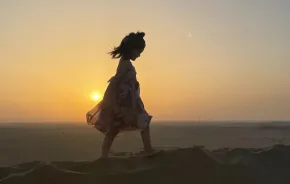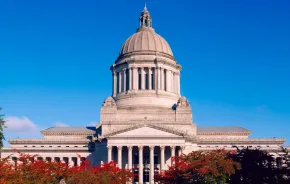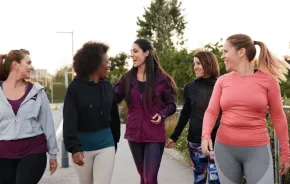Deborah Jensen, Woodland Park Zoo president and chief executive
officer, is a forest ecologist by training and former vice president of
conservation science at the Nature Conservancy who has spent many years
crunching numbers. A hallmark of Jensen's career is making complex data
related to conservation biology understandable and accessible to
everyone.
"Zoos have a unique ability to talk to a very broad section of the
public about why animals are cool, and why you should care about what's
happening to them and what you can do," Jensen says.
Now in her third year at the zoo, the energetic and personable
president seems to be a perfect fit in an era when many zoos strive not
only to draw visitors with showy, lifelike exhibits, but to help them
make connections between the animals they meet at the zoo and how the
animals live -- or struggle to live -- in the wild.
ParentMap spoke with Jensen, our hero this month, about her work and happenings with the zoo.
Q. What are some of the projects that stand out from your previous work in conservation science?
A.
I worked on a study that was trying to look at how to set up a set of
statistics (akin to economic indicators) to evaluate the state of the
nation's ecosystems. We were trying to get a kind of report card for
all these systems everywhere -- how are they doing and are they getting
better or worse. We wanted to create a common language for everyone to
use when they spoke of the health of the environment.
Q. Why are zoos important places for kids today?
A.
I think how fast the world is urbanizing and how quickly most kids
spend almost all their time sedentary. Even in this region where it is
so outdoors-oriented. Very few families say "go outside and play, see
you later." People are busy, they have busy lives and they are afraid
to just let their kids go outside and play. Children have less
unstructured interaction with wildlife than probably most generations
of humans in eternity. I think zoos like ours give children an
opportunity to go play and run around. Whether they think the squirrel
is the coolest thing here, or the jaguar it doesn't quite matter --
it's about full-body play and learning and having these experiences
interacting with your family.
Q.
In the spirit of even more interactive experiences at the zoo, please
talk about the new educational exhibit under construction.
A.
Zoomazium is an indoor interactive learning experience where kids can
play and learn at the same time. We'll have animals you can interact
with and then there's a program called Nature Exchange where you bring
something you've found in the wild. You can come and talk to the
naturalist and get points for what you know about it. You get credits
for your knowledge about wildlife. Once you've gained points, you can
use the points to buy cool stuff: field guide to birds, plastic skull,
whatever you aspire to. It is a way for children to follow their own
interests and get accurate information about what they are interested
in. We are still fundraising for it, and there is some hard work to do
still, but we are hoping to have it open next spring.
Q. Conservation is one of your goals for the zoo. How is the zoo supporting this mission?
A. We hired our first conservation director, a scientist named Dr. Lisa
Dabek, in January of 2005. Lisa has worked with Tree Kangaroos (and
villagers) in Papua, New Guinea. Working with Lisa, [the villagers]
realized that if there is no place in their land where tree kangaroos
are safe from hunting, then the numbers will go down. It's pretty
simple math and they get it right away, as one of their leaders said:
"It was like a message that struck me like an arrow to my heart."
We think that our zoo and many other zoos can have projects like that
around the world, where we are making a difference with local
communities to protect wildlife and providing our visitors an
opportunity to hear some of the successful stories and participate in
going to see them or finding other ways of supporting them. (The Tree
Kangaroo Conservation Program is one of four Partners for Wildlife
projects supported by the zoo. For more information, visit the Partners
for Wildlife program at www.zoo.org/conserve/menu.htm.)
Q. What other projects are you excited about?
A.
I'm really excited about the exhibit that opened this summer called
Willawong Station. It is an interactive aviary full of Australian
birds. You pay $1 and get a seed stick. Birds come down and land on
your hand and eat the seeds right off your seed stick. It is so fun --
I go all the time. It is almost as much fun to watch the expressions of
the other people there as it is to have the bird on your hand.
Q. How has your experience with parenting impacted your feelings about conservation and the environment?
A.
Having a daughter has made very real my concern about the world we are
leaving for our children and grandchildren. While real progress on
environmental issues has been made in the United States in my lifetime,
we have not yet done enough to leave our children better choices rather
than poorer ones.
Q. Can you comment on challenges with balancing the zoo's growth needs with neighborhood concerns?
A.
The zoo has over 1.1 million visitors each year, and our visitation is
expected to grow as a percentage of the region's population growth. We
are working hard to meet the needs of these visitors and meet the
funding needs of this treasured community institution while being
mindful of neighborhoods around us. We're lucky to live in such a
wonderful neighborhood, and we keep them in mind in all of our planning
processes. Some of our new projects, such as the parking garage, will
serve both zoo visitors and our neighbors. Other new projects such as
Zoomazium impact the neighborhoods somewhat during construction. But
the tradeoff is that the facility will continue to be provide
educational and recreational value to our community for years to come.
Rhonda Aronwald, a freelance writer, lives in Seattle with her husband and 7-year-old son.
Zoo Programs
School to Zoo: free through levy funding and supports Seattle School District science kits for K-4.
Wild Wise: available to all middle schools in Washington state.
Save Our Amazing Raptors (SOAR): Available in King County, any grade level.
Teacher training workshops: available to any teacher in the state.
Forest Explorers: Available free to qualifying Seattle schools; available in King County on a fee basis.
Zoo Corps:
Program for teens 14-18 years old, focused on service learning and teen
development through wildlife and conservation education and service.









